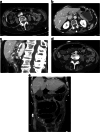CT of acute abdomen in the elderly
- PMID: 40335795
- PMCID: PMC12058634
- DOI: 10.1186/s13244-025-01955-1
CT of acute abdomen in the elderly
Abstract
Abdominal disorders represent 10 to 15% of all Emergency Department visits in elderly patients. This educational review focuses on acute abdomen pathologies specific to the elderly and on their imaging patterns and proposes a strategy for performing CT scans in this population. Bowel obstruction is the most common cause of emergency surgery in the elderly with a higher proportion of colonic obstructions, in particular obstructive colorectal cancer and sigmoid volvulus. Concerning abdominal inflammatory processes, such as cholecystitis, appendicitis, and diverticulitis, gangrenous cholecystitis and complicated appendicitis are relatively frequently encountered due to delayed diagnoses. Bowel ischemia, which includes acute mesenteric ischemia (AMI) and ischemic colitis (IC), is also much more common after the age of 80. Although ischemic colitis is mainly related to cardiovascular risk factors, it can also result from a persistent distension above a colonic cancer or from fecal impaction. Finally, extra-abdominal pathologies responsible for acute abdominal pain, such as inferior myocardial infarction, should not be overlooked. In clinical practice, when possible thanks to sufficient and appropriate radiological resources, we recommend a scan without injection of contrast and an injection depending on the results of the unenhanced scan, decided by the radiologist present at the CT scan room during the examination. CRITICAL RELEVANCE STATEMENT: CT is critical in the diagnosis and management of patients over 75 years old with an acute abdomen, given the difficulty of clinico-biological diagnosis, the frequency of complicated forms, and the morbidity induced by delayed diagnosis. KEY POINTS: The most common site and cause of bowel obstruction in the elderly is large bowel obstruction due to colon cancer. Discrepancy between a poor clinical examination and complicated forms on imaging, particularly for inflammation and infections, is responsible for late diagnosis and increased morbidity. Ischemia, including of the small bowel, colon, and gallbladder are common cause of acute abdomen in elderly. In patients with upper quadrant pain, consider extra-abdominal causes such as pneumonia or myocardial infarction.
Keywords: Acute abdomen; Cholecystitis; Elderly patients; Intestinal obstruction; Mesenteric ischemia.
© 2025. The Author(s).
Conflict of interest statement
Declarations. Ethics approval and consent to participate: Not applicable. Consent for publication: Not applicable. Competing interests: The authors declare that they have no competing interests.
Figures












References
-
- Eurostat (2024) Population structure and ageing. Statistics explained. Retrieved January 09, 2025, from https://ec.europa.eu/eurostat/statistics-explained/index.php?title=Popul...
-
- Neilsberg Research (2024) United States population by age. Retrieved January 09, 2025, from https://www.neilsberg.com/insights/united-states-population-by-age/
-
- Natesan S, Lee J, Volkamer H, Thoureen T (2016) Evidence-based medicine approach to abdominal pain. Emerg Med Clin North Am 34:165–190. 10.1016/j.emc.2015.12.008 - PubMed
-
- Baz Ü, Satar S, Kozacı N, Açıkalın A, Gülen M, Karakurt Ü (2014) Geriatric patient admissions to emergency service. J Acad Emerg Med 13:53–57. 10.5152/jaem.2013.007
LinkOut - more resources
Full Text Sources

